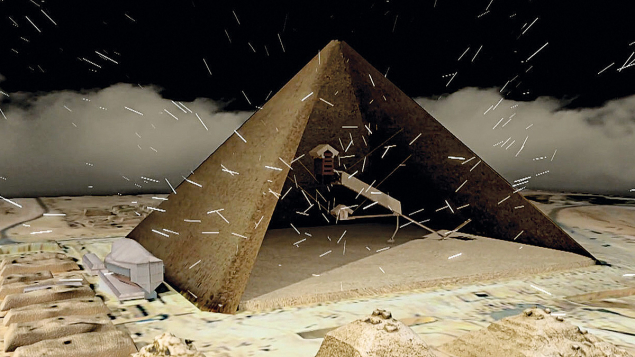Cosmic Ray Muography, edited by Paola Scampoli and Akitaka Ariga, World Scientific

Muon radiography – muography for short – uses cosmic-ray muons to probe and image large, dense objects. Coordinated by editors Paola Scampoli and Akitaka Ariga of the University of Bern, the authors of this book provide an invaluable snapshot of this booming research area. From muon detectors, which differ significantly from those used in fundamental physics research, to applications of muography in scientific, cultural, industrial and societal scenarios, a broad cross section of experts describe the physical principles that underpin modern muography.
Hiroyuki Tanaka of the University of Tokyo begins the book with historical developments and perspectives. He guides readers from the first documented use of cosmic-ray muons in 1955 for rock overburden estimation, to current studies of the sea-level dynamics in Tokyo Bay using muon detectors laid on the seafloor and visionary ideas to bring muography to other planets using teleguided rovers.
Scattering methods
Tanaka limits his discussion to the muon-absorption approach to muography, which images an object by comparing the muon flux before and after – or with and without – an object. The muon-scattering approach, which was invented two decades ago, instead exploits the deflection of muons passing through matter that is due to electromagnetic interactions with nuclei. The interested reader will find several examples of the application of muon scattering in other chapters, particularly that on civil and industrial applications by Davide Pagano (Pavia) and Altea Lorenzon (Padova). Scattering methods have an edge in these fields thanks to their sensitivity to the atomic number of the materials under investigation.

Peter Grieder (Bern), who sadly passed away shortly before the publication of the book, gives an excellent and concise introduction to the physics of cosmic rays, which Paolo Checchia (Padova) expands on, delving into the physics of interactions between muons and matter. Akira Nishio (Nagoya University) describes the history and physical principles of nuclear emulsions. These detectors played an important role in the history of particle physics, but are not very popular now as they cannot provide real-time information. Though modern detectors are a more common choice today, nuclear emulsions still find a niche in muography thanks to their portability. The large accumulation of data from muography experiments requires automatic analysis, for which dedicated scanning systems have been developed. Nishio includes a long and insightful discussion on how the nuclear-emulsions community reacted to supply-chain evolution. The transition from analogue to digital cameras meant that most film-producing firms changed their core business or simply disappeared, and researchers had to take a large part of the production process into their own hands.
Fabio Ambrosino and Giulio Saracino of INFN Napoli next take on the task of providing an overview of the much broader and more popular category of real-time detectors, such as those commonly used in experiments at particle colliders. Elaborating on the requirements set by the cosmic rate and environmental factors, their
chapter explains why scintillator and gas-based tracking devices are the most popular options in muography. They also touch on more exotic detector options, including Cherenkov telescopes and cylindrical tracking detectors that fit in boreholes.
In spite of their superficial similarity, methods that are common in X-ray imaging need quite a lot of ingenuity to be adapted to the context of muography. For example, the source cannot be controlled in muography, and is not monochromatic. Both energy and direction are random and have a very broad distribution, and one cannot afford to take data from more than a few viewpoints. Shogo Nagahara and Seigo Miyamoto of the University of Tokyo provide a specialised but intriguing insight into 3D image reconstruction using filtered back-projection.
A broad cross section of experts describe the physical principles that underpin modern muography
Geoscience is among the most mature applications of muography. While Jacques Marteau (Claude Bernard University Lyon 1) provides a broad overview of decades of activities spanning from volcano studies to the exploration of natural caves, Ryuichi Nishiyama (Tokyo) explores recent studies where muography provided unique data on the shape of the bedrock underneath two major glaciers in the Swiss Alps.
One of the greatest successes of muography is the study of pyramids, which is given ample space in the chapter on archaeology by Kunihiro Morishima (Nagoya). In 1971, Nobel-laureate Luis Alvarez’s team pioneered the use of muography in archaeology during an investigation at the pyramid of Khafre in Giza, Egypt, motivated by his hunch that an unknown large chamber could be hiding in the pyramid. Their data convincingly excluded that possibility, but the attempt can be regarded as launching modern muography (CERN Courier May/June 2023 p32). Half a century later, muography was reintroduced to the exploration of Egyptian pyramids thanks to ScanPyramids – an international project led by particle-physics teams in France and Japan under the supervision of the Heritage Innovation and Preservation Institute. ScanPyramids aims at systematically surveying all of the main pyramids in the Giza complex, and recently made headlines by finding a previously unknown corridor-shaped cavity in Khufu’s Great Pyramid, which is the second largest pyramid in the world. To support the claim, which was initially based on muography alone, the finding was cross-checked with the more traditional surveying method based on ground penetrating radar, and finally confirmed via visual inspection through an endoscope.
Pedagogical focus
This book is a precious resource for anyone approaching muography, from students to senior scientists, and potential practitioners from both academic and industrial communities. There are some other excellent books that have already been published on the same topic, and that have showcased original research, but Cosmic Ray Muography’s pedagogical focus, which prioritises the explanation of timeless first principles, will not become outdated any time soon. Given each chapter was written independently, there is a certain degree of overlap and some incoherence in terminology, but this gives the reader valuable exposure to different perspectives about what matters most in this type of research.







